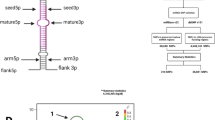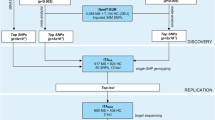Abstract
Recent large-scale association studies have identified over 100 MS risk loci. One of these MS risk variants is single-nucleotide polymorphism (SNP) rs17066096, located ~14 kb downstream of IL22RA2. IL22RA2 represents a compelling MS candidate gene due to the role of IL-22 in autoimmunity; however, rs17066096 does not map into any known functional element. We assessed whether rs17066096 or a nearby proxy SNP may exert pathogenic effects by affecting microRNA-to-mRNA binding and thus IL22RA2 expression using comprehensive in silico predictions, in vitro reporter assays, and genotyping experiments in 6,722 individuals. In silico screening identified two predicted microRNA binding sites in the 3′UTR of IL22RA2 (for hsa-miR-2278 and hsa-miR-411-5p) encompassing a SNP (rs28366) in moderate linkage disequilibrium with rs17066096 (r 2 = 0.4). The binding of both microRNAs to the IL22RA2 3′UTR was confirmed in vitro, but their binding affinities were not significantly affected by rs28366. Association analyses revealed significant association of rs17066096 and MS risk in our independent German dataset (odds ratio = 1.15, P = 3.48 × 10−4), but did not indicate rs28366 to be the cause of this signal. While our study provides independent validation of the association between rs17066096 and MS risk, this signal does not appear to be caused by sequence variants affecting microRNA function.


Similar content being viewed by others
References
International Multiple Sclerosis Genetics Consortium et al (2011) Genetic risk and a primary role for cell-mediated immune mechanisms in multiple sclerosis. Nature 476:214–219
Lill CM et al (2013) Genome-wide significant association of ANKRD55 rs6859219 and multiple sclerosis risk. J Med Genet 50:140–143
International Multiple Sclerosis Genetics Consortium et al (2013) MANBA, CXCR5, SOX8, RPS6KB1 and ZBTB46 are genetic risk loci for multiple sclerosis. Brain 136:1778–1782
International Multiple Sclerosis Genetics Consortium (IMSGC) et al (2013) Analysis of immune-related loci identifies 48 new susceptibility variants for multiple sclerosis. Nat Genet 45:1353–1360
Beyeen AD et al (2010) IL-22RA2 associates with multiple sclerosis and macrophage effector mechanisms in experimental neuroinflammation. J Immunol 185:6883–6890
Sabat R, Ouyang W, Wolk K (2013) Therapeutic opportunities of the IL-22-IL-22R1 system. Nat Rev Drug Discov 13:21–38
Pan H-F, Li X-P, Zheng SG, Ye D-Q (2013) Emerging role of interleukin-22 in autoimmune diseases. Cytokine Growth Factor Rev 24:51–57
Zhu S et al (2012) The microRNA miR-23b suppresses IL-17-associated autoimmune inflammation by targeting TAB2, TAB3 and IKK-α. Nat Med 18:1077–1086
Guerau-de-Arellano M et al (2011) Micro-RNA dysregulation in multiple sclerosis favours pro-inflammatory T-cell-mediated autoimmunity. Brain 134:3578–3589
de Faria O Jr et al (2012) MicroRNA dysregulation in multiple sclerosis. Front Genet 3:311
John B et al (2004) Human MicroRNA targets. PLoS Biol 2:e363
Lewis BP, Shih I, Jones-Rhoades MW, Bartel DP, Burge CB (2003) Prediction of mammalian microRNA targets. Cell 115:787–798
Kertesz M, Iovino N, Unnerstall U, Gaul U, Segal E (2007) The role of site accessibility in microRNA target recognition. Nat Genet 39:1278–1284
1000 Genomes Project Consortium (2010) A map of human genome variation from population-scale sequencing. Nature 467:1061–1073
Schilling M, Ansaloni S, Schröder J, Bertram L (2013) Bioinformatics meets biology: predicting the role of DNA-sequence variants on micro-RNA function. Alzheimers Dement. J Alzheimers Assoc 9:P828
Betel D, Koppal A, Agius P, Sander C, Leslie C (2010) Comprehensive modeling of microRNA targets predicts functional non-conserved and non-canonical sites. Genome Biol 11:R90
Purcell S et al (2007) PLINK: a tool set for whole-genome association and population-based linkage analyses. Am J Hum Genet 81:559–575
Vilardo E, Barbato C, Ciotti M, Cogoni C, Ruberti F (2010) MicroRNA-101 regulates amyloid precursor protein expression in hippocampal neurons. J Biol Chem 285:18344–18351
Long JM, Lahiri DK (2011) MicroRNA-101 downregulates Alzheimer’s amyloid-β precursor protein levels in human cell cultures and is differentially expressed. Biochem Biophys Res Commun 404:889–895
Jacobs JL, Dinman JD (2004) Systematic analysis of bicistronic reporter assay data. Nucleic Acids Res 32:e160
Acknowledgements
We are grateful to the patients and controls participating in this study. This project was funded by grants from the Hans and Ilse Breuer Foundation for Alzheimer’s Research, the Cure Alzheimer's Fund, and the Brain and Behavior Research Foundation (formerly NARSAD; all to L.B.), the German Ministry for Education and Research (BMBF; grant 16SV5538 to L.B., KKNMS to F.Z., grant NBL3 to U.K.Z., grant 01GM1203A to H.-P.H. and O.A., grant 01UW0808 to U.L. and E.S.-T.), the Johannes Gutenberg University Mainz (grants MAIFOR and “Inneruniversitäre Forschungsförderung Stufe I” to F.L.), the Walter- and Ilse-Rose-Stiftung (to H.-P.H. and O.A.), and the Innovation Fund of the Max Planck Society (M.FE.A.LD0002 to U.L.). S.A. and J.S. were supported by fellowships of the Max Planck International Research Network on Aging (MaxNetAging).
Conflicts of interest
None of the authors report any disclosures.
Author information
Authors and Affiliations
Corresponding author
Electronic supplementary material
Below is the link to the electronic supplementary material.
Supplementary Table 1
(PDF 406 kb)
Rights and permissions
About this article
Cite this article
Lill, C.M., Schilling, M., Ansaloni, S. et al. Assessment of microRNA-related SNP effects in the 3′ untranslated region of the IL22RA2 risk locus in multiple sclerosis. Neurogenetics 15, 129–134 (2014). https://doi.org/10.1007/s10048-014-0396-y
Received:
Accepted:
Published:
Issue Date:
DOI: https://doi.org/10.1007/s10048-014-0396-y




